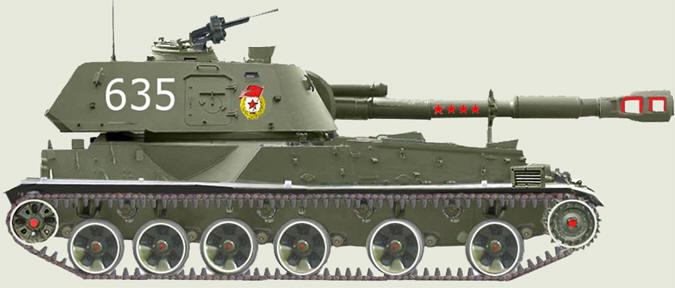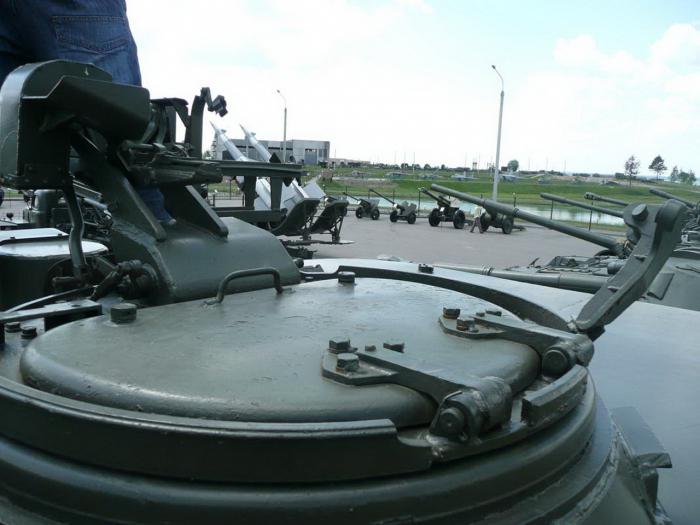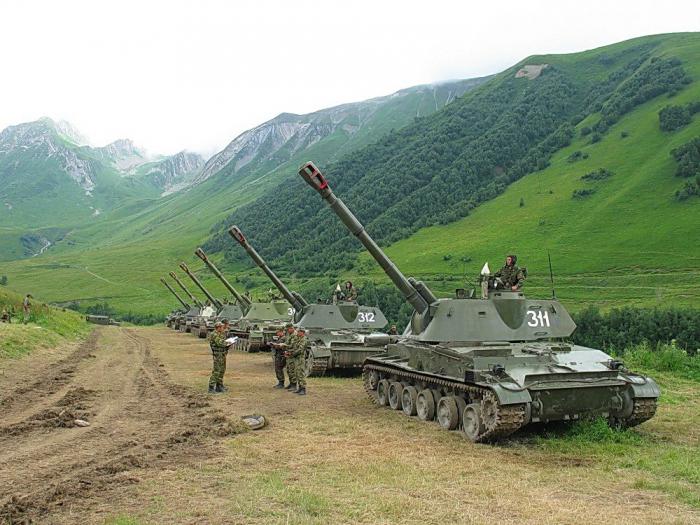"Acacia" - a 152-mm self-propelled howitzer (GABTU index - object 303). Developed by a team of designers of the Ural Transport Engineering Plant under the leadership of F.F. Petrova and G.S. Efimova. ACS 2S3 "Acacia" is designed to destroy and suppress mortar and artillery batteries, enemy manpower, fire weapons, tanks, rocket launchers, tactical means of atomic weapons, command posts and other things.
Generational change
Until the mid-sixties of the last century, self-propelled artillery installations (ACS) of the Second World War, such as the SU-100, ISU-152 and ISU-122, continued to serve in the army of the USSR. These vehicles combined the qualities of cannon-howitzer complexes with anti-tank capabilities. For this versatility, they were liked by the military of the old school, with experience in conducting military operations during the Great Patriotic War. However, with the change of generations of officers and generals, new views on the tactics of using self-propelled artillery in modern warfare gradually formed.
So, in particular, the main enemy of tanks and other armored vehicles is not an ordinary shell, but an anti-tank guided missile (ATGM). In this regard, military experts came to the conclusion that, on the one hand, self-propelled artillery installations should not specialize in the destruction of heavy vehicles, and on the other hand, the new self-propelled guns should not "dress" in thick armor, because ATGM can penetrate even the strongest of them . In addition, according to the new requirements, self-propelled artillery installations must have maximum mobility, air transport and increased buoyancy. In order for the equipment to meet these requirements, it was necessary to abandon heavy armor and give preference to bulletproof protection. As for the placement of the gun, to increase the maneuver by fire, it should not be placed in an armored tank, but in a freely rotating turret, which will allow the complex to conduct circular fire. In addition, one of the main requirements of the military was the creation of the possibility of using updated self-propelled artillery nuclear weapons.
Background
The beginning of work on the Acacia self-propelled guns was preceded by a huge search research work, during which a comparative analysis of the artillery systems created during the Second World War (such as the SU-100, SU-152 and others), as well as the post-war period, was carried out domestic gunsmiths, and foreign. Thus, in the process of research work, organizations and enterprises of the USSR defense complex proposed a number of different chassis variations on which a 152-mm gun would be placed. According to one of them, a self-propelled howitzer was developed on the basis of the tank chassis of the 118, 123 and 124 objects by engineers of the Sverdlovsk Engineering Plant. In this project, it was planned to place the towed cannon D-20 in the tower.

In another variation, it was proposed that the Akatsia self-propelled guns be created on the basis of the nodes and mechanisms of the T-64 medium tank (“Object 432”). Engineers proposed placing a 152-mm gun in an armored turret with a coaxial machine gun. This solution was very popular, as the T-64 was the first post-war tank of the second generation. A lot of new progressive solutions were implemented in it, it was distinguished by its original chassis and automatic loader. At that time, this machine was very popular for the development of promising projects of armored vehicles. However, as a result of studies of the experience of using self-propelled artillery, as well as studies of the appearance of the installation, the concept of the perspective development of self-propelled guns was preferred. And for further work on the creation of self-propelled guns "Acacia" was recommended chassis of the Sverdlovsk Engineering Plant.
History of creation
Based on all of the above technical tasks, by a joint resolution of the USSR Council of Ministers and the CPSU Central Committee No. 609-201 of July 4, 1967, the Sverdlovsk Engineering Plant Uraltransmash was given the terms of reference for the creation of an ACAC 2S3 ACS. Together with the 152-mm complex, the plant’s designers developed a number of other self-propelled artillery systems: the 122-mm howitzers "Gvozdika" and "Violet", as well as the 240-mm mortar "Tulip". Fundamentally new models of self-propelled guns were designed to eliminate the backlog of the USSR from the countries of the NATO bloc in this aspect. "Acacia" was designed to arm the regiments of motorized rifle and tank divisions. This self-propelled howitzer was intended to destroy the enemy’s sheltered and open manpower, military equipment and weapons, as well as other objects to the depth of the division’s interests. The artillery complex was created on the basis of the chassis of the experimental self-propelled guns "Object 105" and "Object 120", as well as the Krug SAM system.
The first two prototypes were created by the end of 1968, however, in the process of testing, serious flaws were revealed, in particular, a very strong gas contamination of the conning tower. Due to this shortcoming, four more samples were created that were created by the summer of next year. After improving the ventilation system, this problem was solved, as a result, the first series of ACS "Akatsiya" (the photos shown in this article clearly demonstrate these machines) was released in 1970. And in 1971 she was adopted. This model was produced unchanged until 1975, after which the troops received an upgraded version of the ACS "Akatsiya" under the 2C3M index. The updated machine had an updated drum-type warhead for twelve charges, which made it possible to increase the rate of fire of the complex and increase the ammunition load. Two years later, the self-propelled gun underwent another modernization (231). Now the 152-mm self-propelled howitzer was equipped with equipment for input, reception, processing, as well as reflection of command data and a new SP-538 sight. In addition, 3OF38 "Centimeter" adjustable shells and 3OF39 "Krasnopol" guided shells were introduced into the ammunition. The last modernized version of the 2S3M2 was different from its predecessors of a more powerful artillery system. Also, this version of the installation was equipped with “Mechanizer-M” receiving-indicator equipment (1514-1), which made it possible to exchange data between the battery’s senior officer’s machine and the gun, thereby reducing the preparation time for the complex to open fire. In general, the self-propelled howitzer "Acacia" was produced until 1993.

Machine description
The artillery installation is made according to the classical scheme with a tower cabin. The complex has an armored welded hull, which is divided into three compartments: control, combat and power (motor-transmission). The first compartment is located between the engine bulkhead and the left side in the bow of the body. Here is the workplace of the driver. The power compartment is located in the front right. It houses the transmission, engine, and powertrain systems. In the rear of the hull is the fighting compartment. On the bottom of the body is a rotating platform that is mounted on a ball pursuit, it rests on five rolls. The gunner’s workplace is located on the left of the gun, and the loader’s on the right. The commander’s chair is located behind the gunner.
The implementation of the self-propelled chassis differs from its predecessors in the use of small-sized tracks with rubber-metal hinges and a front arrangement of drive rollers.
Acacia, 152 mm self-propelled howitzer: artillery unit
The gun (2A33) for this self-propelled gun was developed in OKB-9. The towed howitzer gun D-20 was taken as the basis. The prototype was assembled at Perm Machine-Building Plant No. 172, and mass production was carried out at Barricades. An artillery gun with a vertical wedge bolt, an ejector and a two-chamber muzzle brake is located in a rotary armored closed turret mounted on a reinforced ball bearing. In order to facilitate the loading procedure, the howitzer is equipped with an electromechanical device for sending shells and shells of an original design, as well as a trap-catcher of shot shells. On the roof of the conning tower of the self-propelled guns (photo above), on the left is the commander’s turret, where a machine gun with a remote control is installed, on the starboard side there is a loader hatch. Fire can be conducted from a place, both in normal conditions and in contaminated areas. Ammunition launcher self-propelled artillery (non-modernized model) is located in two mechanized belts. During firing, they can also be fed through a special hatch in the hull from the ground.

Power plants and accessories
On the Akatsia self-propelled howitzer, the developers installed a twelve-cylinder V-type four-stroke turbocharged liquid-cooled engine (B-59). Together with it, a two-line mechanical transmission with planetary rotary mechanisms is used. The artillery installation has an individual torsion bar suspension with hydraulic telescopic shock absorbers. On the self-propelled guns, the designers installed special self-digging equipment that allows you to dig a trench in the ground for shelter in twenty minutes. In order to heat the crew in a self-propelled gun, a heating installation (OV-65G) was installed, the capacity of which is 6500 kcal / hour. This self-propelled artillery system has collective protection, equipped with PPO and PAZ systems, against weapons of mass destruction. 23 is equipped with an automatic fire system, a filter-ventilation installation, a compartment sealing system, which made it possible to protect the crew from the effects of bacteriological, nuclear and chemical weapons. The tightness of the self-propelled howitzer is maintained both during the firing process, and during movement.
Ammunition
For firing from the Akatsia self-propelled howitzer, shells from D-20 and ML-20 cannons are used, as well as from D-1 howitzers. For these systems, NIMI developed a whole line of 152 mm ammunition. For example: a 3VOF33 high-explosive fragmentation projectile with a full alternating charge and a reduced alternating charge, a 3VOF33 long-range projectile, a 3VOF96, 3VOF97, 3VOF98 shot, as well as 3V013 and 3V014 with a fragmentation-and-fragmentation projectile full and reduced alternating charge. Reduced charges allow you to send shells at a short range along a steeper trajectory. This allows you to hit targets that are hidden behind various obstacles, such as houses, hills and more.
For the destruction of heavy armored vehicles using cumulative ammunition BP-540. These shells with an initial velocity of 676 m / s have an impact range of up to five kilometers. Normally, they penetrate tank armor up to 250 mm thick, at an angle of 60 degrees to 220 mm, and at an angle of 30 degrees - up to 120 mm. In addition to the ammunition listed, the ammunition of the self-propelled gun includes special ammunition that serves to disorganize enemy tactical control systems by interfering with ultra-short and short radio waves. For example, 337 and 336 with full and reduced variable charge.

At present, Akatsiya self-propelled howitzers use corrective projectiles of the Centimeter type and guided of the Krasnopol type developed by the NTK Automation and Mechanization of Technologies. So, the “Centimeter” complex is used to destroy armored vehicles in places where artillery systems and launchers are concentrated at firing positions, long-term defensive systems, communications and command posts, bridges and crossings. "Krasnopol" is used to destroy small-sized ground targets in firing conditions from closed firing positions with illuminating targets with a laser beam of a rangefinder.
ACS "Acacia": characteristics
The combat weight of the installation is 27.5 tons (the relatively light weight of Akatsiya allows it to be transported by transport aircraft), the length with the gun pointing forward is 7765 mm, the height is 3050 mm, and the width is 3250 mm. The ACS clearance is 450 mm, the average specific ground pressure is 0.6 kg / cm 2 . Engine power is 520 hp, speed - 2000 rpm. Chassis characteristics: individual suspension, caterpillar type of mover, the 1st and 6th rollers are equipped with hydraulic telescopic shock absorbers, the width of the rubber-metal track is 485 mm, the number of tracks is 115. The fuel supply is 850 liters. The maximum speed is 63 km / h. Cruising range - 500 km. The machine is able to overcome obstacles: rise - 30 degrees, roll - 25 degrees, ditch - 3 meters, wall - 0.7 meters, ford - 1 meter. The frontal armor of the body and turret is 30 mm. The crew of a self-propelled howitzer consists of four people.
Artillery weapons: characteristics
As mentioned earlier, the developers of the 2A33 howitzer are OKB-9 and KB2 of the Perm Machine-Building Plant, and they manufactured it at the Barricades. At Uraltransmash, the final assembly of self-propelled guns was carried out. The characteristics of this gun are as follows: caliber - 152.4 mm, barrel rollback length - 510-750 mm, pointing angles - vertical from -4 to +60 degrees, horizontal - 360 degrees, weight of the swinging part - 2450 kg, rate of fire - 1, 9-3.5 rounds per minute. The shutter part is a semi-automatic vertical wedge-type copying type. Rollback brake - hydraulic spindle. Type of knurl - pneumatic. Charging - separate case. Firing range: 3OF25 shells up to 17.3 km, 3OF22 up to 20.5 km, Krasnopol - up to 20 km.
As an additional weapon used machine gun type PKT 7.62 mm caliber, the ammunition of which is 250 rounds.
Military companies
2C3 Akatsiya self-propelled howitzers have been used quite successfully in many military conflicts that have occurred in different parts of the globe over the past four decades. Western intelligence found out about the presence of these installations in the arsenal of the Soviet Army only in 1973, so it received the code name "Model 1973". Officially, the government of the USSR "lit up" the ACS "Acacia" only in 1977 at the exercises "Carpathians". In the same year, these cars first participated in a parade on Red Square. In 1979, about a hundred 2C3 self-propelled howitzers were delivered to the German Democratic Republic; Iraq became the next country to receive these combat vehicles. During the period of the Iraqi company, Acacia took part in all military operations, however, the military remained unhappy with the insufficient, in their opinion, firing range.
From the very beginning of hostilities in Afghanistan, these artillery installations were involved in the artillery units of a limited contingent of Soviet troops. Military experts noted the high reliability of the complex, but it could not do without flaws. The main disadvantages of self-propelled guns are recognized as insufficient firing range and rate of fire. An interesting fact is that in Afghanistan these combat vehicles were mainly used for direct fire, which had a great demoralizing effect on the Mujahideen. The same technique is now used by the Syrian military against Islamic militants.
Self-propelled guns "Acacia" participated in all armed conflicts in the former USSR. For example, in companies in the North Caucasus, as well as during the so-called “888 War.”
Today, these military artillery installations are used in the conflict in Ukraine, both by regular troops and militias.
Conclusion
At present, our army is armed with both modern self-propelled artillery mounts and production from the times of the USSR. The howitzer "Acacia", despite its considerable age, continues to regularly carry out combat duty not only in the Russian army, but also abroad. These artillery pieces were delivered to Europe: Warsaw Pact countries; to the African continent: Algeria, Iraq, Libya, Syria. In addition, after the collapse of the Soviet Union, these machines remained in all the former Soviet republics without exception. Demand for this type of armament is not weakening today, orders are being received both for artillery mounts of the times of the USSR and for new self-propelled guns of Russia. Indeed, in modern warfare, such systems, combined with high-precision guided munitions, can play a key role. In action, Acacia proved to be the best, military experts note the simplicity and reliability of this artillery complex. And after her participation in an Afghan company, she became very popular. Perhaps that is why it remains in service not only in our country, but also in many other countries of the world.